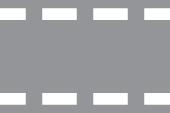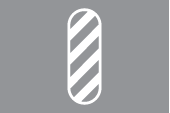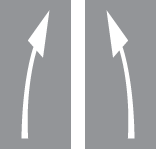
7.1
7.1 - used to separate the two directions of traffic on roads with two or three lanes, mark the borders of the lane on dangerous road sections, mark the carriageway entry prohibition sections or the border of the vehicle parking places;

7.2
7.2 (continuous wide line) - used to mark the edges of carriageways;

7.3
7.3 - used to separate the two directions of traffic on roads with four or more lanes;

7.4
7.4 - used for marking the places prohibited for standing and is put alone or in conjunction with sign 2.27 on the edges of carriageways and on curbstones;

7.5
7.5 (the length of the strokes of broken lines is three times shorter the length of the gaps between them) - used to separate the two directions of traffic on roads with two or three lanes and mark the borders of lanes on roads having two or more lanes with the same directions of traffic;

7.6
7.6 (the length of the strokes of broken lines is three times longer the length of the gaps between them) - warns of approaching to the markings 7.1 and 7.10 separating traffic flows in the same or opposite directions;

7.7
7.7 (the length of the strokes of broken lines is equal to the length of the gaps between them) - used to mark the traffic lanes on intersections;

7.8
7.8 (broken wide line) - used for marking the acceleration and deceleration lane borders;

7.9
7.9 - used for marking the places prohibited for parking and is put alone or in conjunction with sign 2.28 on the edges of carriageways and on curbstones;

7.10
7.10 - separates traffic flows in the same or opposite directions. The marking is used to mark the borders of parallel lanes where taking a position is permitted from only one, the places for entry from only one of the traffic flows to the opposite traffic flow and exits where entry to and exit from are permitted only from one side;

7.11
7.11 “Stop-line” - used for marking the places where vehicles should stop in order to fulfill the instructions of prohibition signals given by traffic lights or authorized officials or sign 3.5;

7.12
7.12 - used for marking the places where vehicles should stop to give way to vehicles moving through the across roads (in order to fulfill the instructions of sign 3.4);

7.13.а

7.13.б
7.13.а,б “Pedestrian crossing” - used for marking the places where pedestrians cross the carriageways:
7.13.а - marking for not regulated pedestrian crossings (pedestrian traffic direction could be indicated by arrows on this marking);
7.13.б - marking for regulated pedestrian crossings.

7.14
7.14 “Safety zone” - marking of places where pedestrians not managed to cross the carriageway during changing the signals given by traffic lights or authorized officials should wait for the next permitting signal. It is used in conjunction with the marking 7.13.б;

7.15
7.15 - used for places where cycle tracks cross with carriageways;

7.16.а

7.16.б

7.16.в
7.16.а,б,в - used for marking the space and direction on approaches to places where traffic flows join together or branch off:
7.16.а - space to separate the two directions of traffic;
7.16.б - space isolating the section where traffic flow in the same direction branches off;
7.16.в - space isolating the section where traffic flows in the same direction join together.

7.17
7.17 - used for marking route vehicle stops and taxi stands and used in conjunction with sign 5.32 or 5.33;

7.18
7.18 “Direction indicatory arrow” - indicates the direction to enter an intersection from the given lane and is used stand-alone or in conjunction with signs 5.10.а,б. It is allowed to make a U-turn as well from the left-hand side edge lane indicated with left-turn arrows;

7.19
7.19 “Guiding arrow” - warns of narrowing the carriageway (decreasing the number of lanes in the given direction) or approaching to the markings 7.1 and 7.10 separating traffic flows in the opposite directions. It could be used in conjunction with the signs 1.15.а,б,в;

7.20
7.20 - warns of approaching to the marking 7.12. The top of the triangle is pointed against the traffic flow;

7.21
7.21 “Stop-inscription” - warns of approaching to the marking 7.11 used in conjunction with sign 3.5;

7.22
7.22 - used for indicating the number of a road (route) and used stand-alone or in conjunction with signs 5.26.а,б.